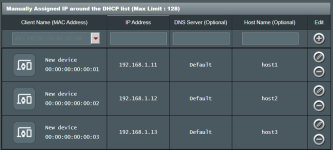dominatorstang
Occasional Visitor
I am trying to better configure my network and better utilize DNS. The more I try to do this, the more I think my thinking is a bit off with it.
All my devices use a subnet mask of 255.255.252.0
My DHCP pool is 192.168.2.20-100
services hosted on 192.168.0.x and 192.168.1.x
cameras on 192.168.3.x
I setup on the router for domain as "mydomain.com" and router is named "router"
I am able to access my router at router.mydomain.com
Now I also did the same for other devices and services I have on the network, but in general the static IP devices do no work properly for me using this method.
Then on a windows PC it does not allow you to just use a name on the domain, it wants to join and then I seen the advanced ipv4 settings to put the suffix too, but not sure that is what I am needing either. Am I doing this right? lol
Also just to make sure I understand the subnet mask. With all devices having 255.255.252.0 mask, allows any device from 192.168.0.x-192.168.3.x can communicate with each other across a layer2 switch even if the gateway/router is down.
All my devices use a subnet mask of 255.255.252.0
My DHCP pool is 192.168.2.20-100
services hosted on 192.168.0.x and 192.168.1.x
cameras on 192.168.3.x
I setup on the router for domain as "mydomain.com" and router is named "router"
I am able to access my router at router.mydomain.com
Now I also did the same for other devices and services I have on the network, but in general the static IP devices do no work properly for me using this method.
Then on a windows PC it does not allow you to just use a name on the domain, it wants to join and then I seen the advanced ipv4 settings to put the suffix too, but not sure that is what I am needing either. Am I doing this right? lol
Also just to make sure I understand the subnet mask. With all devices having 255.255.252.0 mask, allows any device from 192.168.0.x-192.168.3.x can communicate with each other across a layer2 switch even if the gateway/router is down.


